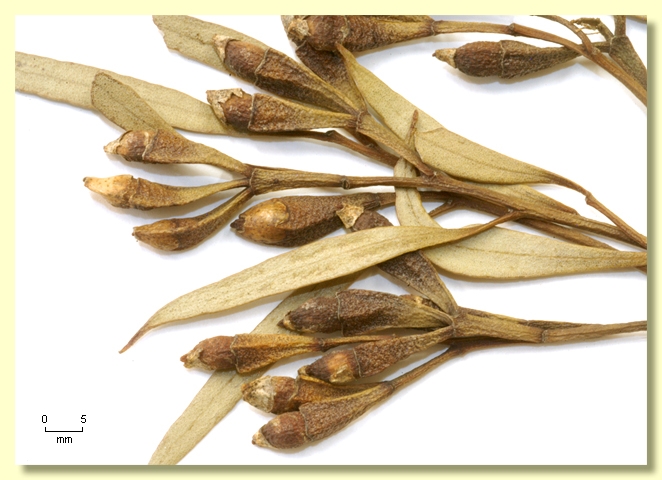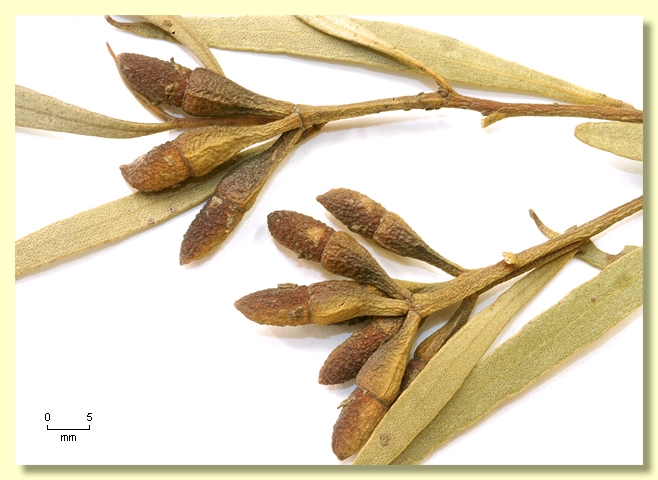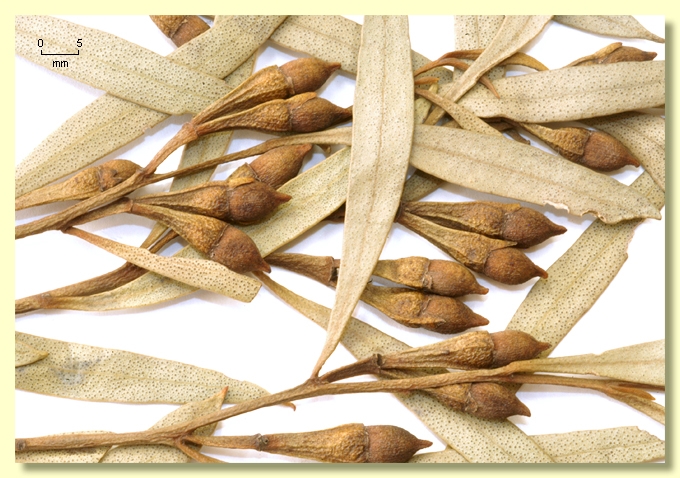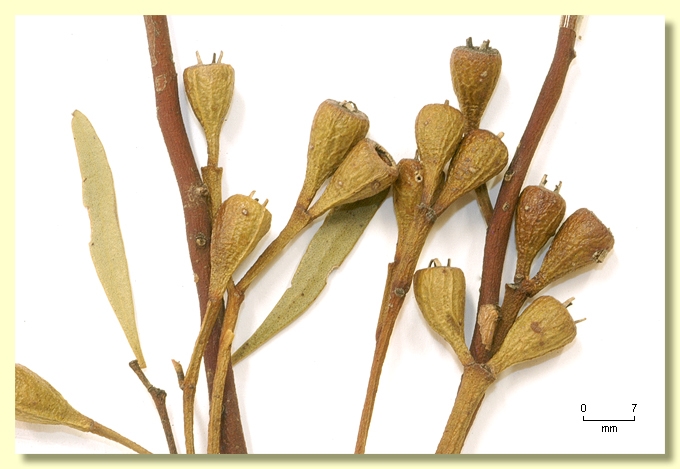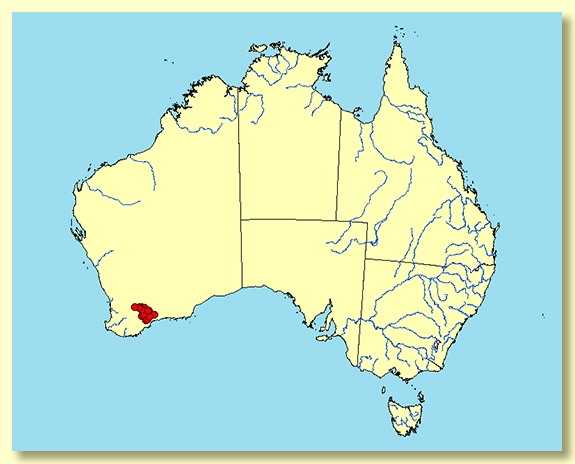Eucalyptus | Symphyomyrtus | Bisectae | Glandulosae | Erectae | Abundae
Euclid - Online edition
Eucalyptus suggrandis subsp. promiscua
Mallee to 5 m tall. Forming a lignotuber.
Bark smooth throughout, pale shiny or silvery grey over coppery or yellow.
Branchlets have oil glands in the pith.
Juvenile growth (coppice or field seedlings to 50 cm): stems rounded or squared in cross-section, green, smooth; leaves always shortly petiolate, alternate, linear to narrowly lanceolate, 3.2-6.7 cm long, 0.6-1.2 cm wide, base tapering, margin entire or with a few indentations, apex acute or apiculate, green, dull or slightly glossy.
Adult leaves held erect, alternate, with petioles to 0.7 cm long; blade linear to narrowly elliptical, 3.3-7 cm long, 0.3-1 cm wide, base tapering to petiole, margin entire or distantly indented, apex pointed, concolorous, glossy, green, the surface appearing "glazed", only the midrib and sometimes part of the intramarginal vein visible, all other venation obscured by numerous round oil glands, or, if side-veins are visible, then acute and incomplete.
Inflorescence axillary unbranched, peduncles more or less flattened, widening apically, 0.6–2.2 cm long, buds 3 per umbel, on pedicels 0.3-1.2 cm long. Mature buds ovoid-fusiform (1.1–1.7 cm long, 0.4–0.6 cm wide), hypanthium clearly 2 or 3-ridged/angled (rarely 4-angled), tapering to a flattened pedicel, operculum scar usually absent because the outer operculum rarely sheds whole but commonly fragments during bud development or splits with parts remaining on rim of flower/fruit as calyx lobes, inner operculum pointed or shortly beaked, as long as the hypanthium, sometimes slightly warty, stamens all erect, anthers versatile, dorsifixed, dehiscing by longitudinal slits, style long and straight arising from a conical ovary roof, stigma blunt, locules 3 or 4, the placentae each with 4 (sometimes 6) vertical rows of ovules. Flowers creamy white.
Fruit pedicellate (pedicels 0.3-1.2 cm long), obconical, 0.6–1.5 cm long, 0.5–0.9 cm wide, conspicuously 2 or 3 ribbed/angled (rarely with 4 angles), disc descending, hidden by the conspicuous flat persistent staminophore, valves 3 or 4, at rim level or appearing exserted due to the persistent style fragments.
Seeds brown, 0.8–2 mm long, ovoid, dorsal surface clearly but shallowly reticulate (not pitted), hilum ventral.
Cultivated seedlings (measured at node 10): cotyledons Y-shaped (bisected); not grown yet.
Eucalyptus suggrandis (with 2 subspecies) is a mallee species endemic to Western Australia, occurring generally through the southern and eastern fringes of the wheatbelt extending to sub-coastal heath areas from Jerramungup to Scadden. The stems are smooth, adult leaves erect, green, glossy and have numerous oil glands, and buds are usually in 3s or 7s with the base of the bud weakly or conspicuously 2 or 3 ribbed/angled.
Eucalyptus suggrandis belongs in Eucalyptus subgenus Symphyomyrtus section Bisectae subsection Glandulosae because the buds have an operculum scar, cotyledons are bisected and branchlets have oil glands in the pith. Within this large subsection (ca 80 species) Eucalyptus suggrandis is closely related to a group of mallees and mallets (series Erectae subseries Abundae) recognised by the glazed leaf surface, leaves with a great density of oil glands that obscures the venation, peduncles moderately long and flattened, inflorescences spreading to pendulous and buds with erect stamens.
There are two subspecies:
E. suggrandis subsp. suggrandis
Usually has 7-flowered bud clusters on flattened though variably broad peduncles (quite strap-like on some plants). Buds and fruit have 2 slight ribs on the base or are scarcely ribbed. The outer (calycine) operculum sheds whole to leave an operculum scar, and the inner operculum is usually slightly warty to extremely so, rarely almost smooth. Subsp. suggrandis occurs in coastal and sub-coastal heath from the Bremer Bay and Gairdner River south of Jerramungup, extending east and north-east through the catchments of the Fitzgerald River, Phillips River, Oldfield River, Young River and Lort River and to the north of Esperance. Plants in Fitzgerald River National Park area have quite broad leaves and very warty inner operculum. Usually found in mallee comminities on sandplain or sandy clay soil.
E. suggrandis subsp. promiscua
Has buds in 3s on flattish peduncles that broaden apically. The buds shed the outer operculum tardily, or as fragments or scales, or sometimes has sepals in the bud stage (rather than an outer operculum formed from united sepals). The lower part of bud and the fruit have 2, 3 or rarely 4 angles/ribs that are more prominent than in subsp. suggrandis. Adult leaves are generally narrower than those of subsp. suggrandis. Distributed in an area bounded by Pingaring, Lake Grace, Jerramungup, Lake Magenta, Newdegate and Lake King, where found on flattish or low-lying areas of sandy clay.
Species in the same geographic area and having pith glands in the branchlets, leaves with numerous oil glands and buds with erect stamens and thus likely to be confused with E. suggrandis, can be distinguished as follows. The mallee habit distinguishes E. suggrandis from its closest relative the mallet E. alipes which is found in the south-eastern wheatbelt and Hyden scrub. The mallets of the Newdegate area, E. mimica subsp. mimica and subsp. continens, share outer operculum features with E. suggrandis subsp. promiscua and differ only in their taller and non-lignotuberous habit. The south-eastern wheatbelt mallees E. depauperata, with its relatively short operculum, and E. tenera with longer opeculum, differ from E. suggrandis in lacking both warts and ribs/angles on the buds. The salt tolerant mallet E. spathulata and related mallee E. orthostemon both have smaller, non-warty, non-ribbed/angled buds and consistently linear crown leaves, compared with E. suggrandis.
The related mallee species with inflexed stamens in bud, E. vegrandis, tends to have smaller, non-warty buds compared with E. suggrandis.
Similarly the mallee E. proxima and the mallet E. cernua, both from the Ravensthorpe to Hopetoun area, differ from E. suggrandis subsp. suggrandis, also found in this area, in having inflexed stamens in bud: all three taxa may have reddish flowers, though this is rare in E. suggrandis.
To confidently identify these narrow leaf mallees the botanist will need to section buds lengthwise amd inspect the stamen arrangement, be familiar with the way the outer operculum sheds during bud development and be able to assess in the field the lignotuber status of the plant.
Eucalyptus suggrandis: Latin suggrandis, rather large, referring to the buds and fruits compared with related species.
subsp. promiscua: Latin promiscuus meaning mixed or promiscuous, referring to its relationships with other closely related taxa viz. E. alipes, E. mimica and E. goniocarpa.

